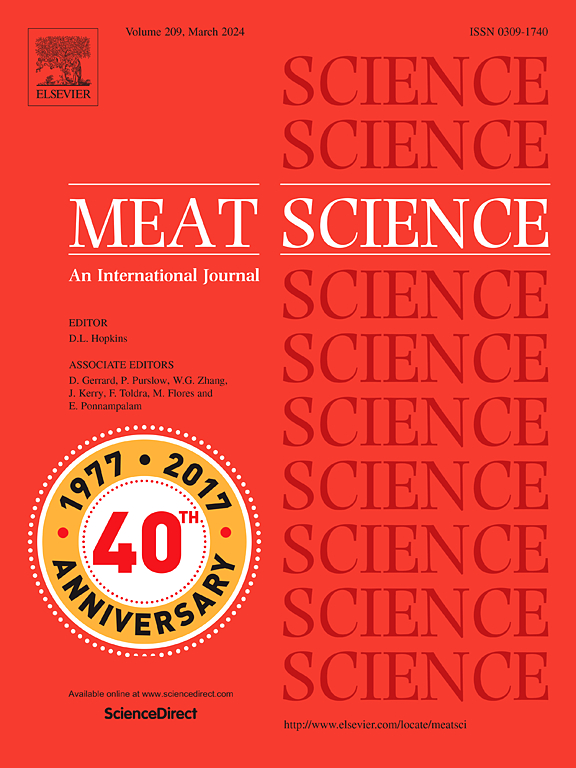干腌肉制品的减盐策略:使用氯化钾和微胶囊香料和芳香植物提取物。
IF 6.1
1区 农林科学
Q1 Agricultural and Biological Sciences
引用次数: 0
摘要
世界卫生组织设定了到2025年将盐摄入量减少30%的目标。研究了用KCl和微囊化香料及芳香植物提取物(ME)代替33% NaCl对干腌肉肠(CMS)的影响。在整个加工和储存过程中进行微生物、物理化学和感官分析。采用对照(1.5% NaCl)、F1 (1% NaCl、0.5% KCl)、F2 (1% NaCl、0.5% ME、0.3% KCl)和F3 (1% NaCl、0.5% ME) 4种配方制备了3批CMS。证实未检出单核增生李斯特菌。该制剂对乳酸菌(7.8 log cfu/g)、肠球菌(6.5 log cfu/g)和凝固酶阴性葡萄球菌(5.6 log cfu/g)的生长没有影响。添加KCl和/或ME的香肠颜色较红,生物胺含量显著增加(P 0.05)。54%的消费者认为CMS F1具有理想的咸味,这通常被认为足以在市场上推出产品。在CMS中使用ME具有潜力,但仍需要优化。研究表明,用KCl代替33%的NaCl是可行的,且不会影响CMS的感官特性和安全性。本文章由计算机程序翻译,如有差异,请以英文原文为准。
Salt reduction strategies for dry cured meat products: The use of KCl and microencapsulated spices and aromatic plant extracts
The World Health Organization set a goal of reducing salt intake by 30 % by 2025. This study investigates the impact of replacing 33 % NaCl with KCl and microencapsulated spices and aromatic plant extracts (ME) in a dry-cured meat sausage (CMS). Microbial, physico-chemical, and sensory analyses were conducted throughout processing and storage. Three batches of CMS were prepared with four formulations: Control (1.5 % NaCl), F1 (1 % NaCl, 0.5 % KCl), F2 (1 % NaCl, 0.5 % ME, 0.3 % KCl), and F3 (1 % NaCl, 0.5 % ME). The absence of Listeria monocytogenes was confirmed. The formulations did not affect the growth of lactic acid bacteria (7.8 log cfu/g), Enterococci (6.5 log cfu/g), and coagulase-negative staphylococci (5.6 log cfu/g). Biogenic amines increased significantly (P < 0.05) during storage, with cadaverine (from 166 to 456 mg/kg), tyramine (163 to 424 mg/kg) and putrescine (from 31.0 to 90.5 mg/kg), being the most abundant. All low sodium CMS had lower TBARS values (F1 = 0.59 mg MDA/kg, F2 = 0.56 mg MDA/kg and F3 = 0.47 mg MDA/kg) compared to control (0.78 mg MDA/kg). Colour parameters lightness (L*) and yellowness (b*) remained stable (P > 0.05) while sausages with KCl and/or ME were redder. CMS F1 was considered with the ideal saltiness by 54 % consumers, that is usually considered enough to launch the product in the market. The use of ME in CMS has potential but still requires optimization. The study demonstrates that a 33 % NaCl replacement with KCl is feasible without jeopardize the organoleptic characteristics or safety of CMS.
求助全文
通过发布文献求助,成功后即可免费获取论文全文。
去求助
来源期刊

Meat Science
工程技术-食品科技
CiteScore
12.60
自引率
9.90%
发文量
282
审稿时长
60 days
期刊介绍:
The aim of Meat Science is to serve as a suitable platform for the dissemination of interdisciplinary and international knowledge on all factors influencing the properties of meat. While the journal primarily focuses on the flesh of mammals, contributions related to poultry will be considered if they enhance the overall understanding of the relationship between muscle nature and meat quality post mortem. Additionally, papers on large birds (e.g., emus, ostriches) as well as wild-captured mammals and crocodiles will be welcomed.
 求助内容:
求助内容: 应助结果提醒方式:
应助结果提醒方式:


